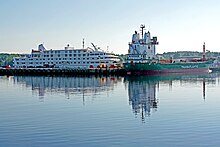Shelburne, Nova Scotia
Shelburne lies at the southwest corner of Nova Scotia, at roughly the same latitude as Portland, Maine, in the United States.
The displacement of the Nova Scotia's Mi'kmaq communities consists of a long and painful history including the introduction of European diseases in the 1500s, the occupation of unceded land, as well as removal of Indigenous children from their homes in the 20th century through the Sixties Scoop and Residential School program.
During this period, homes and communities were destroyed and burned, and Acadian families were separated and forcibly moved throughout the American colonies or into Europe.
Many of Shelburne County's Acadian residents landed in Massachusetts, and throughout the Grand Derangement some were imprisoned, some died at sea, others fled to Quebec, New Brunswick, Prince Edward Island, or sought shelter with Nova Scotia's Mi'kmaq communities.
In 1783, 10,000 enslaved persons (a fifth of the United States' black population) fought alongside British soldiers in the American Revolution-promised freedom in return.
Departing from New York, many Loyalists relocated to Nova Scotia at the end of the war, with 5,000 arriving in Shelburne Harbour in the first wave.
Upon arrival, Black Loyalists waited for land grants from the British authorities that were delayed, smaller, and in worse locations than their white counterparts.
By 1784, the population of Port Roseway (now the Town of Shelburne) reached 10,000-larger than Halifax or Montreal, and housing some of New York's wealthiest families.
But tensions were soon on the upswing, with Nova Scotian slave owners feeling threatened by the presence of these freed Black Loyalists, and white refugees frustrated at trying to compete for work, unwilling to accept such low compensations.
On July 26, 1784, a mob of white Loyalists settlers stormed the home of a black preacher in Shelburne armed with hooks and chains stolen from harboured ships, inciting North America's first race riot.
Only one person was ever charged in connection with these riots, and the event is considered reflective of the broader racist prejudices encountered by Black Loyalists throughout Nova Scotia for the years to come.
While ship building is no longer a major employer, visitors can visit the J C Williams Dory Shop to witness construction methods of the late 19th century.
They set up a small fishing settlement known as Port Razoir in the late 17th century, named after the harbour's resemblance to an open razor.
[4][5] On May 14, 1715, New England naval commander Cyprian Southack attempted to create a permanent fishing station at a place he named "Cape Roseway" (now known as Shelburne).
Pirate Ned Low raided the New England fishing fleet at Shelburne Harbour in 1723, capturing 13 ships and taking Philip Ashton captive.
But the Black Loyalists had to endure long waits before receiving land, were granted less than the whites, and faced discrimination from other colonists, including some who had even taken enslaved people with them to Canada.
[9] But, initial hopes were short-lived; the settlement suffered from a lack of viable agricultural land, poor inland transportation links, and too few pioneers who knew how to develop frontier property.
They became the core of an ethnic group that became known as Krios (for Creoles), which included numerous black poor of London (many of them also African Americans resettled after the American Revolution), formerly enslaved persons resettled from Jamaica, and persons liberated from illegal trading ships after Britain and the United States prohibited the Atlantic slave trade.
The present-day Christ Church (Anglican) is on the site of the original building of the same name, which was designed by Loyalist Isaac Hildreth and consecrated by Bishop Charles Inglis in 1790.
Other economic activities include tourism, aquaculture, fish processing, and the manufacture of barrels, granite monuments, and marine supplies.
In February 2012, the Canadian Food Inspection Agency quarantined one site due to a suspected outbreak of infectious salmon anemia (ISA).
Due to its coastal location and the moderating influence of the Atlantic Ocean, Shelburne's climate is relatively temperate without major extremes in temperature.
Spring is cool and frequently damp, while summer features heavy morning fogs in June and early July, usually followed by clear, warm days until the end of September.
Snowfall that lies on the ground is uncommon until January and Shelburne are susceptible to strong coastal storms called Nor'easters, which bring heavy rains, pounding surf and damaging winds.
[21] The roots of these communities were established after the 1776 American Revolutionary War which forced the relocation and settlement of Black Loyalists to Canadian lands.
The burning of waste over decades created ample amounts of air pollution which were breathed in by surrounding communities, raising major health concerns.
[23] SEED allowed members of the community to express their concerns regarding the Morvan Road Landfill, forming partnerships to address these issues.
Further raising awareness about health concerns, they conducted research to determine the link between cancer rates within the African Nova Scotian communities in the south end.
[23] SEED collaborated with the ENRICH project to conduct research on the water quality, in search of contaminants that might explain the increased cancer rates.
The series stars William Hurt as Ahab, Gillian Anderson as his wife Elizabeth, Ethan Hawke as Starbuck and Donald Sutherland as Father Mappel.


